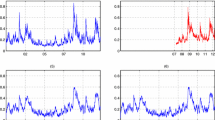Abstract
This paper features a market implied methodology to infer adequate starting values for the spot and long-run variances and for the mean reversion rate of a calibration exercise under the Heston model. More particularly, these initial parameters are obtained by matching the term structure of the future expected total variance, inferred from the volatility surface, with the model term structure. In the numerical study, we compare the goodness of fit and the parameter stability of the Heston model calibrated by using either plausible random or market implied starting values for a one-year sample period including the recent credit crunch. In particular, we show that the proposed methodology avoids getting stuck in one “bad” local minimum and stabilizes the calibrated parameters through time.









Similar content being viewed by others
Notes
An out-of-the-money call option is characterized by K i >F 0 and an out-of-the-money put option by K i <F 0.
Arbitrage opportunities can only be detected from the term structure of the cumulated variance v(T) and not from the term structure of the annualized variance, i.e., \(\text{VIX}^{2}(T) := \frac{1}{T} \mbox{v}(T)\), due to the scaling by the time horizon T in the annualized variance. This explains why we have opted for fitting the total variance curve instead of the annualized variance one.
References
Guillaume, F., Schoutens, W.: Illustrating the impact of calibration risk under the Heston model. Rev. Deriv. Res. 15(1), 57–79 (2012)
Mikhailov, S., Nögel, U.: Heston’s stochastic volatility model implementation, calibration and some extensions. Wilmott Mag. July, 74–79 (2003)
Forde, M., Jacquier, A., Mijatovic, A.: Asymptotic formulae for implied volatility in the Heston model. Proc. R. Soc. A, Math. Phys. Eng. Sci. 466(2124), 3593–3620 (2010)
Gatheral, J., Jacquier, A.: Convergence of Heston to SVI. Quant. Finance 11(8), 1129–1132 (2011)
Lee, R.W.: The moment formula for implied volatility at extreme strikes. Math. Finance 14(3), 469–480 (2004)
Breeden, D., Litzenberger, R.: Prices of state contingent claims implicit in option prices. J. Bus. 51(6), 621–651 (1978)
Chicago Board Options Exchange: The CBOE volatility index—VIX. Working paper, Chicago (2003)
Heston, S.: A closed-form solution for options with stochastic volatility with applications to bond and currency options. Rev. Financ. Stud. 6(2), 327–343 (1993)
Wilmott, P.: Paul Wilmott on Quantitative Finance. Wiley, New York (2006)
Cox, J.C., Ingersoll, J.E., Ross, S.A.: A theory of the term structure of interest rates. Econometrica 53(2), 385–407 (1985)
Demeterfi, K., Derman, E., Kamal, M., Zou, J.: More than You Ever Wanted to Know About Volatility Swaps. Quantitative Strategies Research Notes (1999). Goldman Sachs
Whaley, R.E.: Understanding the VIX. J. Portf. Manag. 35(3), 98–105 (2009)
Gatheral, J.: The Volatility Surface—A Practitioner’s Guide. Wiley, New York (2006)
Murphy, D.: The causes of the credit crunch: a backwards look? Quant. Finance 9(7), 775–790 (2009)
Schöbel, R., Zhu, J.: Stochastic volatility with an Ornstein–Uhlenbeck process: an extension. Eur. Finance Rev. 3, 23–46 (1999)
Barndorff-Nielsen, O.E., Shephard, N.: Non-Gaussian Ornstein–Uhlenbeck-based models and some of their uses in financial economics. J. R. Stat. Soc. 63, 167–241 (2001)
Guillaume, F., Schoutens, W.: A moment matching market implied calibration. Quant. Finance (2013). doi:10.1080/14697688.2013.794950
Author information
Authors and Affiliations
Corresponding author
Additional information
Florence Guillaume is a postdoctoral fellow of the Fund for Scientific Research–Flanders (Belgium) (F.W.O.).
Rights and permissions
About this article
Cite this article
Guillaume, F., Schoutens, W. Heston Model: The Variance Swap Calibration. J Optim Theory Appl 161, 76–89 (2014). https://doi.org/10.1007/s10957-013-0331-7
Received:
Accepted:
Published:
Issue Date:
DOI: https://doi.org/10.1007/s10957-013-0331-7




